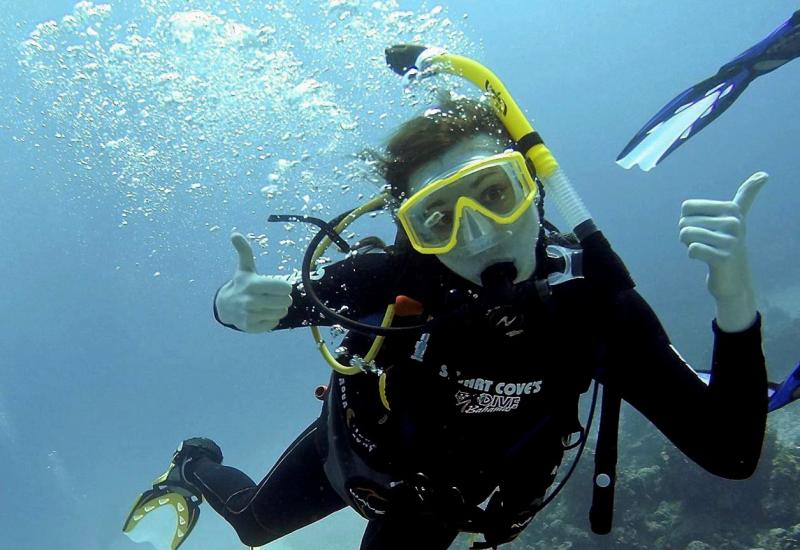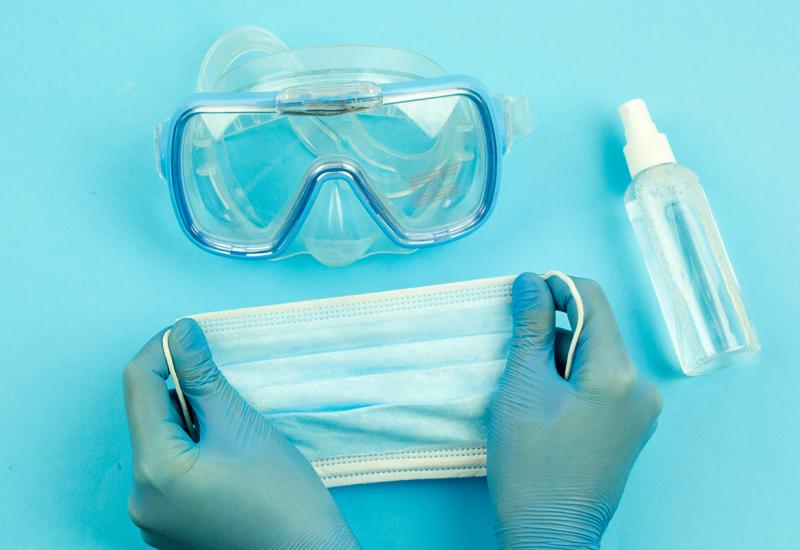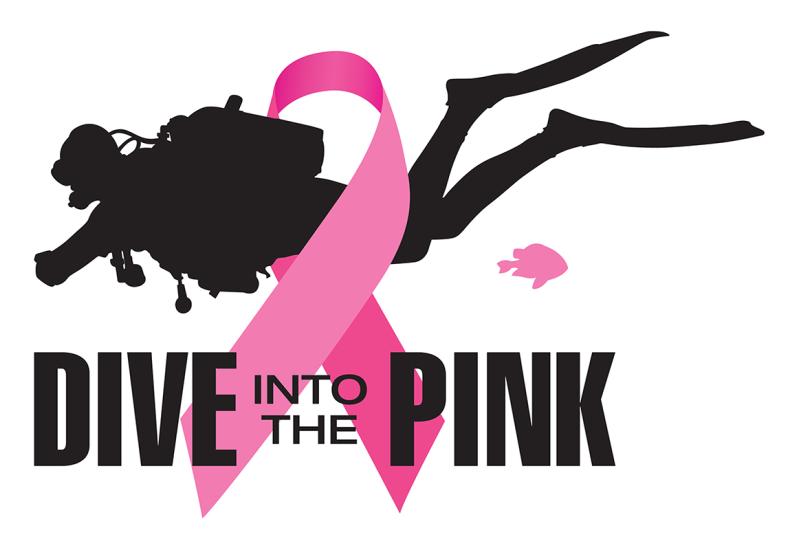Use Less Air Through Yoga
March 2003
By Selene Yeager
The average diver sightseeing at 30 feet in warm, calm seas can expect an average tank of air to last about an hour. But as any diver can tell you, our sport is anything but average. Deeper dives, stronger currents and chilly water can drastically reduce bottom time. New divers, a little panicky and prone to "panting" rather than easy breathing, have been known to suck a tank dry in 15 minutes.
Obviously, increasing your physical fitness is one way to get more out of every breath, but even fit divers can find themselves breathing too fast or too shallow from the stress of diving. That's where yoga comes in. Like scuba, yoga places emphasis on proper inhalation and exhalation, as breathing is considered the essential connection between body and mind. "Practiced regularly, yoga promotes deep, slow breathing, and teaches you how to calm your mind," says diver and yoga instructor Prisca Boris, who co-founded Yoga for Athletes, a Vail, Colo., training facility. Yoga also strengthens and stretches muscles that are important in diving. This all adds up to more quality time admiring the marine life on your next dive, says Boris.
"Last year while diving in Roatan, I was the only one with any air left in my tank when we surfaced, and I think yoga is the reason," she says. "I wasn't panicky. I wasn't sore or tired. I swam comfortably and easily. Yoga teaches you to control your breathing while your body is working, so you can calmly and efficiently deliver more oxygen to your muscles."
Deep Lung Breathing
To fully appreciate yoga's breathing benefits, it helps to understand what happens when you breathe. The primary function of your lungs is to draw in oxygen-rich air and expel the carbon dioxide waste your cells generate. That oxygen/carbon dioxide exchange happens in the alveoli, microscopic, grape-like sacs that line your lungs. On dry land, we typically use just a fraction of our lung space, leaving scores of alveoli untouched. At depth, many of us, especially infrequent or newbie divers, use even fewer alveoli per breath, as water pressure and "mouth-only" breathing can lead to more shallow, rapid breaths. Even experienced divers can find themselves with fewer psi than they'd like when dive conditions aren't ideal.
The solution is breathing slowly and fully, especially on exhalation. Your impulse to breathe is triggered more by a buildup of carbon dioxide than by low oxygen, so by learning to exhale fully, you clear more carbon dioxide and automatically breathe more slowly, says longtime yoga instructor, Arielle Thomas Newman, who offers Yoga for Scuba Diver workshops and designs yoga/scuba vacations at her Kansas City, Mo., shop. "Slower breathing also improves your concentration and focus. Circumstances can turn so suddenly in the water. Something big floats below you and your heart rate soars. Yoga teaches you how to center yourself again." {mospagebreak}
Breathe In, Breathe Out
Yoga uses a technique called ujjayi (OO-jeye) breathing, which translates into "expand successfully"--precisely what you're training your lungs to do. When doing ujjayi breathing, you pull slow, steady breaths, fully filling and emptying your lungs. To promote this type of controlled, measured breathing, yoga instructors recommend breathing drills.
"Deep breathing exercises such as those used in yoga training help keep blood gases normal and are very beneficial as a relaxing technique," says pulmonary expert Paul Davenport, Ph.D., who has worked with Navy divers. What's more, the breathing techniques you learn in yoga affect your breathing behavior in other activities and give you a tool to fall back on in physically or mentally challenging situations, like being 100 feet down in murky water. The following are two drills Newman recommends. Practice them every day and you'll begin to reap the benefits almost immediately.
Open Arms Breathing
-
Sit on the floor in a comfortable position. Place your hands together in front of your chest in a prayer-like position with your thumbs touching your sternum.
-
Inhale through your nose slowly and deeply while extending your arms in front of you and opening them fully out to the sides. Time the movement with the breath, so your arms are fully outstretched at the same time your lungs are at full capacity.
-
Exhale slowly, reversing the arm motion and arriving back to the starting position at the same time your lungs are completely empty. Repeat five times.
Extended Exhalation
-
Sit on the floor with your back against a wall, arms comfortably at your sides.
-
Breathe out slowly and fully, counting the number of seconds it takes you to exhale completly.
-
Inhale slowly. Then exhale again, this time trying to extend the length of the exhalation by one to two counts. Repeat five times.
Grace Under Pressure
No matter how good your gear or your fitness, diving can be an awkward sport. Maneuvering in and out of the water, negotiating ladders and fighting currents can leave even the best divers breathless. Another benefit of yoga is that the physical poses (called asanas) strengthen and stretch your muscles and connective tissues, leaving you in better shape for virtually any physical activity--including scuba.
The following asanas open your chest cavity and promote strength and flexibility in your back, hamstrings, quadriceps and calves, the places you need it most when you're hauling a garage sale of gear on your back. "Mastering these poses leaves you feeling balanced, strong and competent for your next dive," says Prisca Boris. Perform each pose one to three times, holding the pose at least 10 seconds, working up to a full minute. Breathe deeply throughout. {mospagebreak}
Locust
-
Lie on your stomach with your chin on the floor and your arms at your sides, hands under your thighs. Your palms should be facing up, and pressing gently on your legs.
-
Raise your head, chest and legs off the floor as high as comfortably possible, tilting your head back and keeping your legs and feet together
-
Hold. Then lower yourself back to starting position. Turn your head to the side to relax before repeating the pose.
Crescent Moon

-
From a standing position, bend forward and place your fingertips or palms on the floor beside your feet (you can bend your knees).
-
Take a big step back with your right leg, raising your torso and head.
-
Bring your hands over your head, palms together, thumbs crossed.
-
Arch your body from the toes of your right foot through your leg and torso up to your fingertips.
-
Tilt your head back to look to the ceiling.
-
Hold. Then release. Switch legs.
Triangle

-
Stand with your feet wide apart in a straddle stance. Turn your right foot out 90 degrees and turn the left foot out about 45 degrees, while you continue to face forward.
-
Lift arms out to your sides.
-
Bend to the side and reach your right hand down your right leg as far as comfortably possible, while extending your left hand up toward the ceiling. Look up toward the ceiling.
-
Hold. Then release. Switch sides.
{mospagebreak}
Forward Bend

-
Sit on the floor with your back straight and feet out in front of you with your toes pointed up toward the ceiling. Push heels away from your body to lengthen the legs as much as possible.
-
Reach your arms over your head.
-
Keeping your ears between your upper arms and your eyes looking at your fingertips, bend forward and reach toward your feet dropping as far as comfortably possible without rounding your back or bending your knees.
-
Hold. Then release.
Eagle

-
Stand with your feet together and arms by your sides.
-
Bend your left knee and bring your left foot upward. Cross the left leg over the right so your left thigh is resting on your right thigh. Bend your right leg slightly and wrap the left foot behind the right leg.
-
Cross your arms at the elbows, left over right. Bend your arms, bringing your palms together so your hands are in front of your face and fingers are pointed upward.
-
Hold. Then release. Switch sides.
March 2003
By Selene Yeager
The average diver sightseeing at 30 feet in warm, calm seas can expect an average tank of air to last about an hour. But as any diver can tell you, our sport is anything but average. Deeper dives, stronger currents and chilly water can drastically reduce bottom time. New divers, a little panicky and prone to "panting" rather than easy breathing, have been known to suck a tank dry in 15 minutes.
Obviously, increasing your physical fitness is one way to get more out of every breath, but even fit divers can find themselves breathing too fast or too shallow from the stress of diving. That's where yoga comes in. Like scuba, yoga places emphasis on proper inhalation and exhalation, as breathing is considered the essential connection between body and mind. "Practiced regularly, yoga promotes deep, slow breathing, and teaches you how to calm your mind," says diver and yoga instructor Prisca Boris, who co-founded Yoga for Athletes, a Vail, Colo., training facility. Yoga also strengthens and stretches muscles that are important in diving. This all adds up to more quality time admiring the marine life on your next dive, says Boris.
"Last year while diving in Roatan, I was the only one with any air left in my tank when we surfaced, and I think yoga is the reason," she says. "I wasn't panicky. I wasn't sore or tired. I swam comfortably and easily. Yoga teaches you to control your breathing while your body is working, so you can calmly and efficiently deliver more oxygen to your muscles."
Deep Lung Breathing
To fully appreciate yoga's breathing benefits, it helps to understand what happens when you breathe. The primary function of your lungs is to draw in oxygen-rich air and expel the carbon dioxide waste your cells generate. That oxygen/carbon dioxide exchange happens in the alveoli, microscopic, grape-like sacs that line your lungs. On dry land, we typically use just a fraction of our lung space, leaving scores of alveoli untouched. At depth, many of us, especially infrequent or newbie divers, use even fewer alveoli per breath, as water pressure and "mouth-only" breathing can lead to more shallow, rapid breaths. Even experienced divers can find themselves with fewer psi than they'd like when dive conditions aren't ideal.
The solution is breathing slowly and fully, especially on exhalation. Your impulse to breathe is triggered more by a buildup of carbon dioxide than by low oxygen, so by learning to exhale fully, you clear more carbon dioxide and automatically breathe more slowly, says longtime yoga instructor, Arielle Thomas Newman, who offers Yoga for Scuba Diver workshops and designs yoga/scuba vacations at her Kansas City, Mo., shop. "Slower breathing also improves your concentration and focus. Circumstances can turn so suddenly in the water. Something big floats below you and your heart rate soars. Yoga teaches you how to center yourself again." {mospagebreak}
Breathe In, Breathe Out
Yoga uses a technique called ujjayi (OO-jeye) breathing, which translates into "expand successfully"--precisely what you're training your lungs to do. When doing ujjayi breathing, you pull slow, steady breaths, fully filling and emptying your lungs. To promote this type of controlled, measured breathing, yoga instructors recommend breathing drills.
"Deep breathing exercises such as those used in yoga training help keep blood gases normal and are very beneficial as a relaxing technique," says pulmonary expert Paul Davenport, Ph.D., who has worked with Navy divers. What's more, the breathing techniques you learn in yoga affect your breathing behavior in other activities and give you a tool to fall back on in physically or mentally challenging situations, like being 100 feet down in murky water. The following are two drills Newman recommends. Practice them every day and you'll begin to reap the benefits almost immediately.
Open Arms Breathing
Sit on the floor in a comfortable position. Place your hands together in front of your chest in a prayer-like position with your thumbs touching your sternum.
Inhale through your nose slowly and deeply while extending your arms in front of you and opening them fully out to the sides. Time the movement with the breath, so your arms are fully outstretched at the same time your lungs are at full capacity.
Exhale slowly, reversing the arm motion and arriving back to the starting position at the same time your lungs are completely empty. Repeat five times.
Extended Exhalation
Sit on the floor with your back against a wall, arms comfortably at your sides.
Breathe out slowly and fully, counting the number of seconds it takes you to exhale completly.
Inhale slowly. Then exhale again, this time trying to extend the length of the exhalation by one to two counts. Repeat five times.
Grace Under Pressure
No matter how good your gear or your fitness, diving can be an awkward sport. Maneuvering in and out of the water, negotiating ladders and fighting currents can leave even the best divers breathless. Another benefit of yoga is that the physical poses (called asanas) strengthen and stretch your muscles and connective tissues, leaving you in better shape for virtually any physical activity--including scuba.
The following asanas open your chest cavity and promote strength and flexibility in your back, hamstrings, quadriceps and calves, the places you need it most when you're hauling a garage sale of gear on your back. "Mastering these poses leaves you feeling balanced, strong and competent for your next dive," says Prisca Boris. Perform each pose one to three times, holding the pose at least 10 seconds, working up to a full minute. Breathe deeply throughout. {mospagebreak}
Locust
Lie on your stomach with your chin on the floor and your arms at your sides, hands under your thighs. Your palms should be facing up, and pressing gently on your legs.
Raise your head, chest and legs off the floor as high as comfortably possible, tilting your head back and keeping your legs and feet together
Hold. Then lower yourself back to starting position. Turn your head to the side to relax before repeating the pose.
Crescent Moon
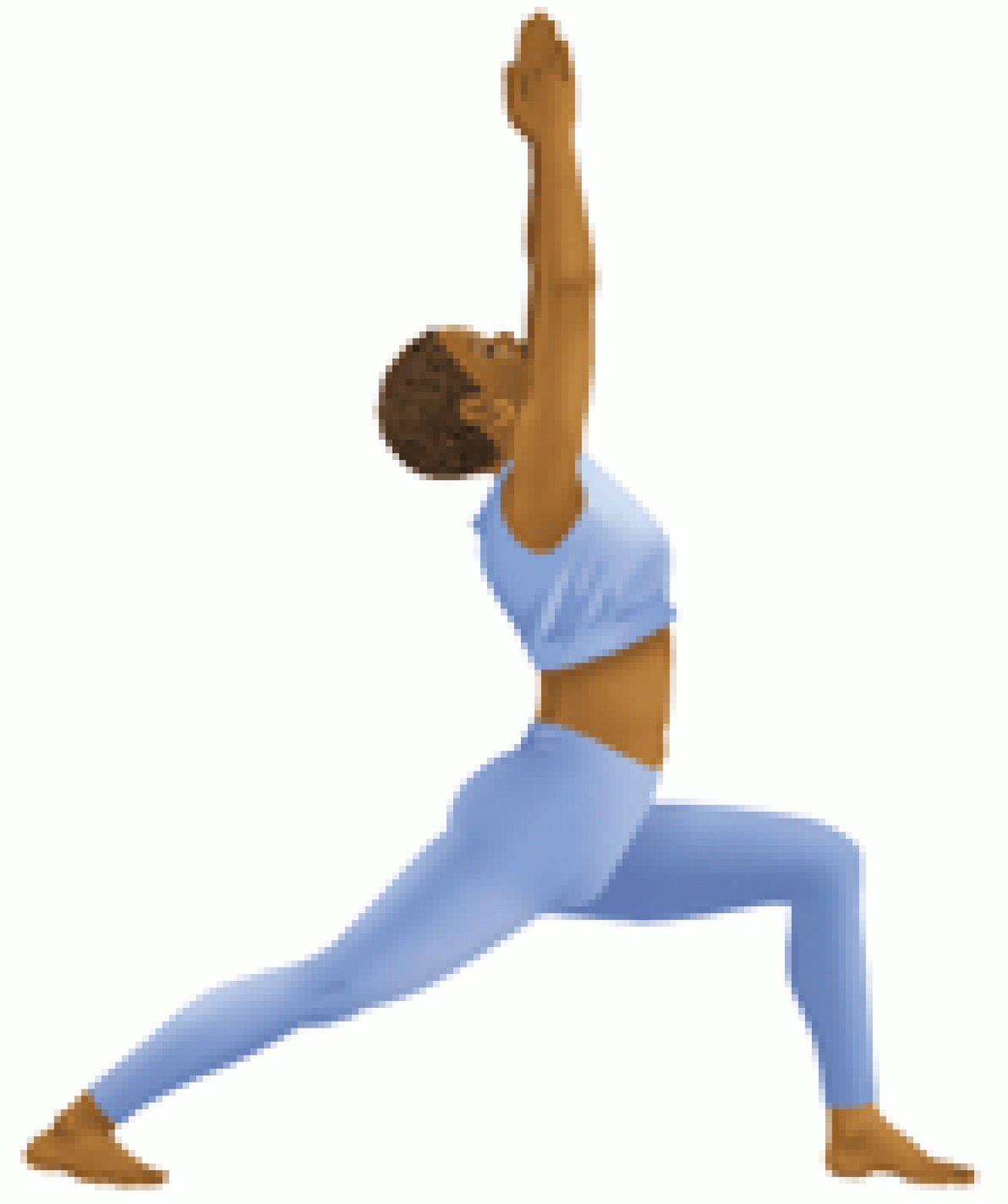
From a standing position, bend forward and place your fingertips or palms on the floor beside your feet (you can bend your knees).
Take a big step back with your right leg, raising your torso and head.
Bring your hands over your head, palms together, thumbs crossed.
Arch your body from the toes of your right foot through your leg and torso up to your fingertips.
Tilt your head back to look to the ceiling.
Hold. Then release. Switch legs.
Triangle
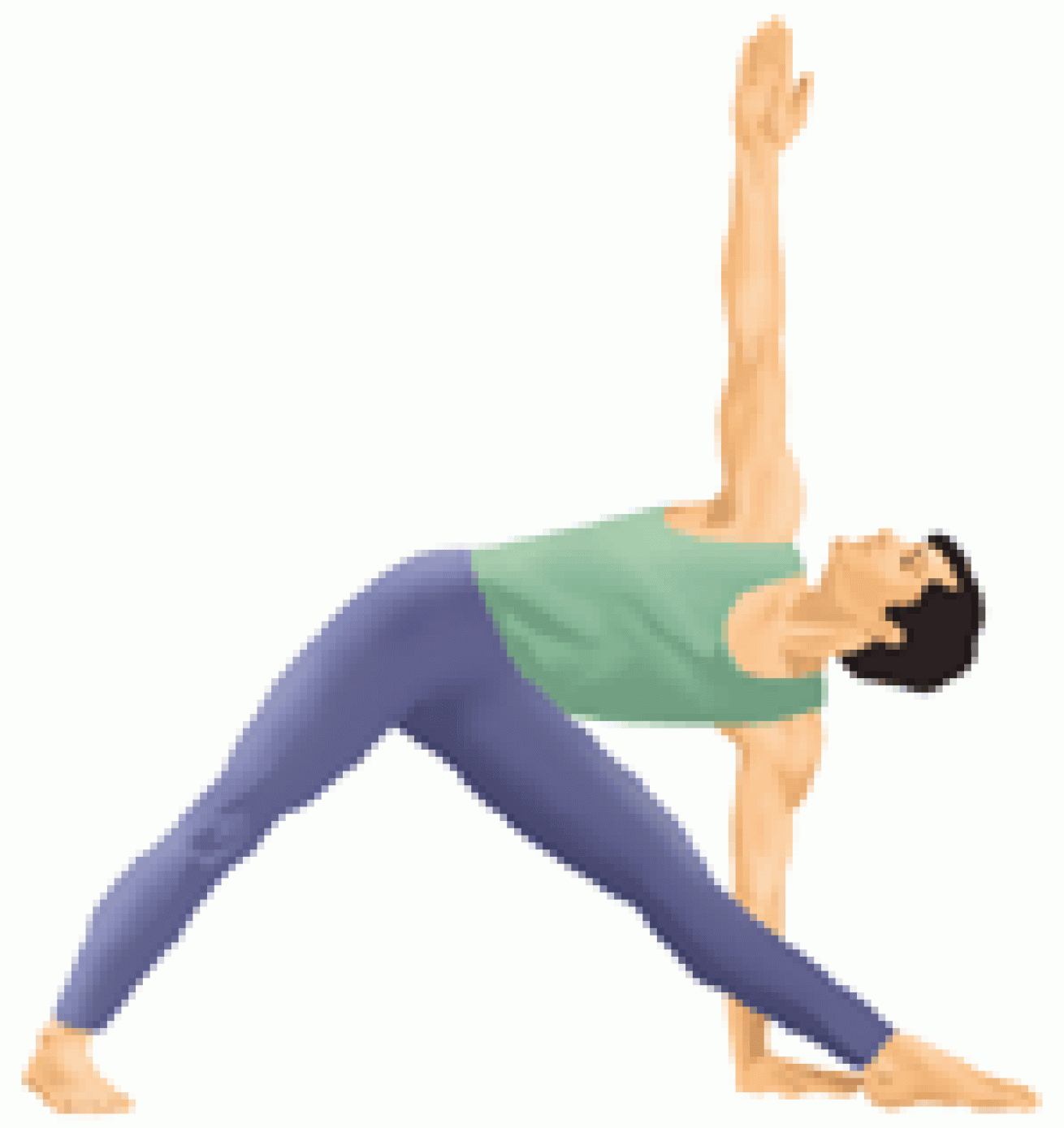
Stand with your feet wide apart in a straddle stance. Turn your right foot out 90 degrees and turn the left foot out about 45 degrees, while you continue to face forward.
Lift arms out to your sides.
Bend to the side and reach your right hand down your right leg as far as comfortably possible, while extending your left hand up toward the ceiling. Look up toward the ceiling.
Hold. Then release. Switch sides.
{mospagebreak}
Forward Bend
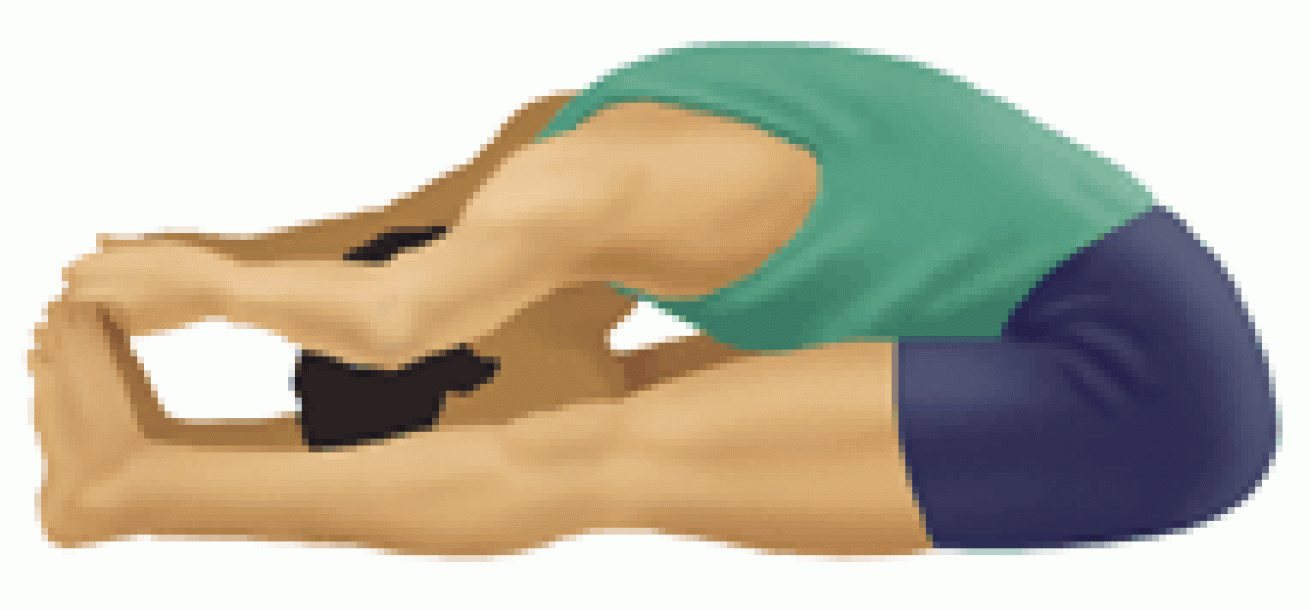
Sit on the floor with your back straight and feet out in front of you with your toes pointed up toward the ceiling. Push heels away from your body to lengthen the legs as much as possible.
Reach your arms over your head.
Keeping your ears between your upper arms and your eyes looking at your fingertips, bend forward and reach toward your feet dropping as far as comfortably possible without rounding your back or bending your knees.
Hold. Then release.
Eagle
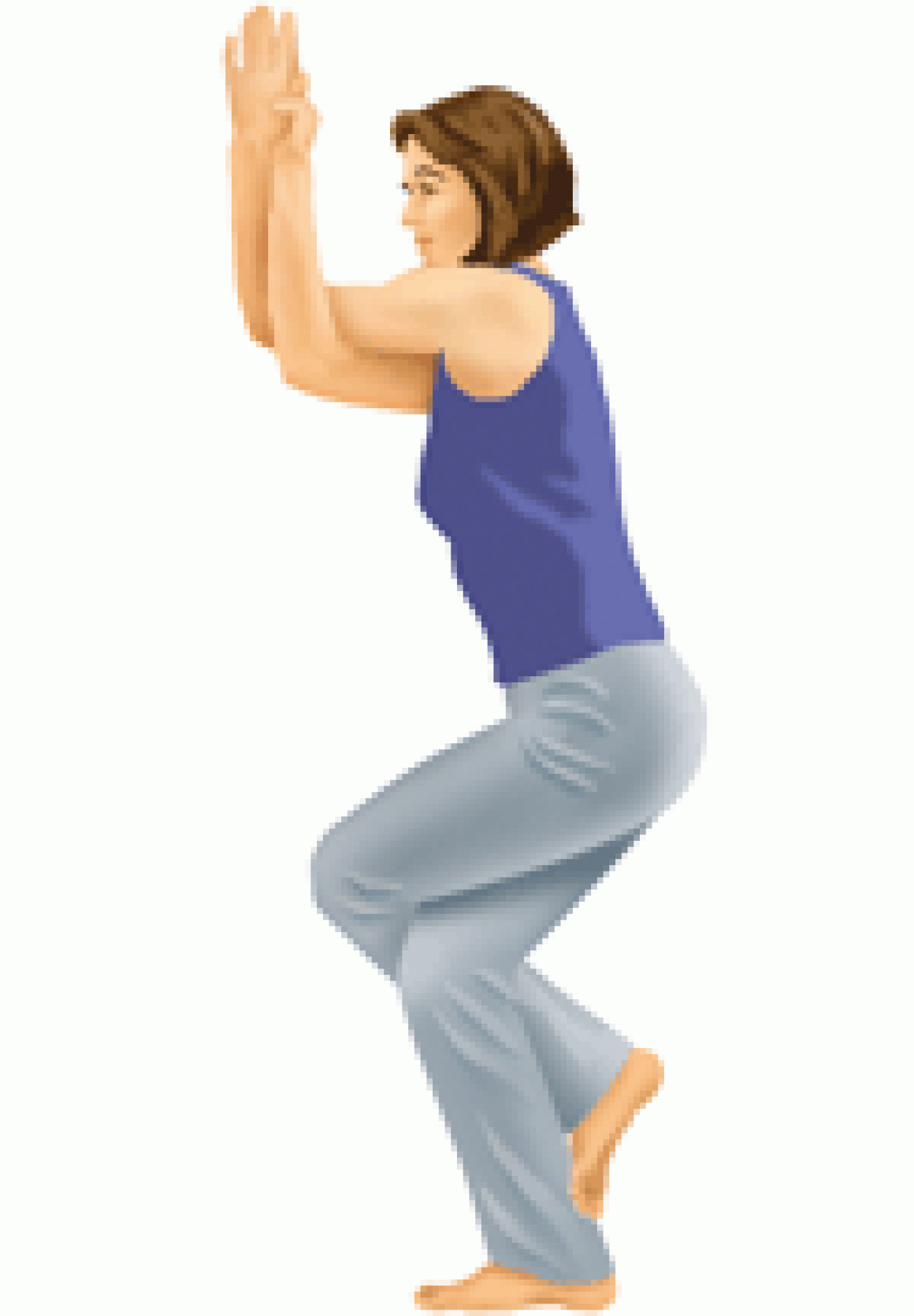
Stand with your feet together and arms by your sides.
Bend your left knee and bring your left foot upward. Cross the left leg over the right so your left thigh is resting on your right thigh. Bend your right leg slightly and wrap the left foot behind the right leg.
Cross your arms at the elbows, left over right. Bend your arms, bringing your palms together so your hands are in front of your face and fingers are pointed upward.
Hold. Then release. Switch sides.

